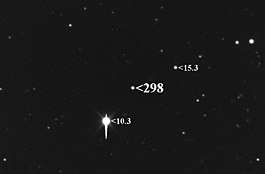Baptistina family
The Baptistina family (FIN: 403) is an asteroid family of more than 2500 members that was probably produced by the breakup of an asteroid 170 km (110 mi) across 80 million years ago following an impact with a smaller body. The two largest presumed remnants of the parent asteroid are main-belt asteroids 298 Baptistina and 1696 Nurmela. The Baptistina family is part of the larger Flora clan.[1][2] It was initially speculated that the Chicxulub impactor was part of the Baptistina family of asteroids, but this was disproven in 2011 using data from the Wide-field Infrared Survey Explorer (WISE).

The Baptistina family consists of darkly colored asteroids and meteoroids in similar orbits. Many mountain-sized fragments from the collision would have leaked into the inner solar system through orbital resonances with Mars and Jupiter, causing a prolonged series of asteroid impacts. Previously, this collision was believed to have occurred about 160 million years ago, and many impacts between 100 and 50 million years ago were attributed to it. However, in 2011, data from WISE revised the date of the proposed collision which broke up the parent asteroid to about 80 million years ago.[3]
Composition
It was originally thought that the Baptistina family may consist of uncommon carbonaceous chondrite. In 2006, nine asteroids within the Baptistina family were given known classifications: three are S-type asteroids, two are X-type asteroids, another two are A/R-type asteroids, one is C-type and one is V-type. However, any conclusions taken from this were highly speculative, as very few members in the family were classified, and not even the albedo of the meteors was known at the time.[1]
Following the impact of the Chelyabinsk meteor in 2013, a paper published in the journal Icarus showed that shock produced during impact of a large asteroid can darken otherwise bright silicate material. Spectral analysis of the darkly-colored portions of the non-carbonaceous Chelyabinsk meteorite closely matched the color of members of the Baptistina family, showing that a low albedo does not necessarily indicate the composition of the family.[4]
Suspected impacts
In 2007, it was proposed that chromium concentrations in 66-million-year-old sediment layers at the Cretaceous–Paleogene boundary (K–T boundary) on Earth suggested that the impactor that gouged out Chicxulub Crater and caused the Cretaceous–Paleogene extinction event belonged to the Baptistina family.[5][6] Concerns were raised regarding the reputed link, in part because very few solid observational constraints existed of the asteroid or family.[7] One year later, it was discovered that 298 Baptistina does not share the same chemical signature as the source of the Cretaceous–Paleogene boundary.[8] Because of the timeframe, it had also been suggested that the impactor that produced the lunar crater Tycho 108 million years ago was also a member of the group,[9] as well as the Venusian craters Mead, Isabella, Meitner, and Klenova.[6]
In 2011, data from the Wide-field Infrared Survey Explorer (WISE) revised the date of the proposed collision which broke up the Baptistina parent asteroid to about 80 million years ago. If correct, this data means it is very unlikely that the K–T impactor was part of this family of asteroids, as it typically takes many tens of millions of years for an asteroid to reach a resonance with Earth and then collide, much more than the 15 million between this breakup and the collision of the K–T impactor.[3] "As a result of the WISE science team's investigation, the demise of the dinosaurs remains in the cold case files," said Lindley Johnson, program executive for the Near Earth Object Observation Program.[10]
References
- Alvarez-Candal, A.; Duffard, R.; Lazzaro, D.; Michtchenko, T. (December 2006). "The inner region of the asteroid Main Belt: a spectroscopic and dynamic analysis" (PDF). Astronomy and Astrophysics. 459 (3): 969–976. Bibcode:2006A&A...459..969A. doi:10.1051/0004-6361:20065518. Retrieved 21 April 2018.
- Nesvorný, D.; Broz, M.; Carruba, V. (December 2014). Identification and Dynamical Properties of Asteroid Families. Asteroids IV. p. 23. arXiv:1502.01628. Bibcode:2015aste.book..297N. doi:10.2458/azu_uapress_9780816532131-ch016. ISBN 9780816532131.
- Plotner, Tammy (2011). "Did Asteroid Baptistina Kill the Dinosaurs? Think other WISE..." Universe Today. Retrieved 19 September 2011.
- "Russian meteorite sheds light on dinosaur extinction mystery". phys.org. 17 July 2014.
- Bottke, WF; Vokrouhlický D.; Nesvorný D. (2007). "An asteroid breakup 160 Myr ago as the probable source of the K/T impactor". Nature. 449 (7158): 48–53. Bibcode:2007Natur.449...48B. doi:10.1038/nature06070. PMID 17805288.
- Govert Schilling. "Asteroids Smash, Dinosaurs Duck". Archived from the original on 27 September 2007. Retrieved 5 September 2007.
- Majaess D., Higgins D., Molnar L., Haegert M., Lane D., Turner D., Nielsen I. (2008). New Constraints on the Asteroid 298 Baptistina, the Alleged Family Member of the K/T Impactor Archived 14 June 2017 at the Wayback Machine, accepted for publication in the JRASC
- Reddy V., et al. (2008). Composition of 298 Baptistina: Implications for K-T Impactor Link, Asteroids, Comets, Meteors conference.
- "Breakup event in the main asteroid belt likely caused dinosaur extinction 65 million years ago". phys.org. 5 September 2007.
- "Asteroid didn't do it - so who killed the dinosaurs? NASA rules out Baptistina theory". News.com.au / Fox. 2011. Retrieved 29 February 2012.
External links
- Bottke, W. F.; Vokrouhlický, D; Nesvorný, D. (6 July 2007). "An Asteroid Breakup 160 My Ago as the Probable Source of the K-T Impactor" (PDF). Nature. PMID 17805288.